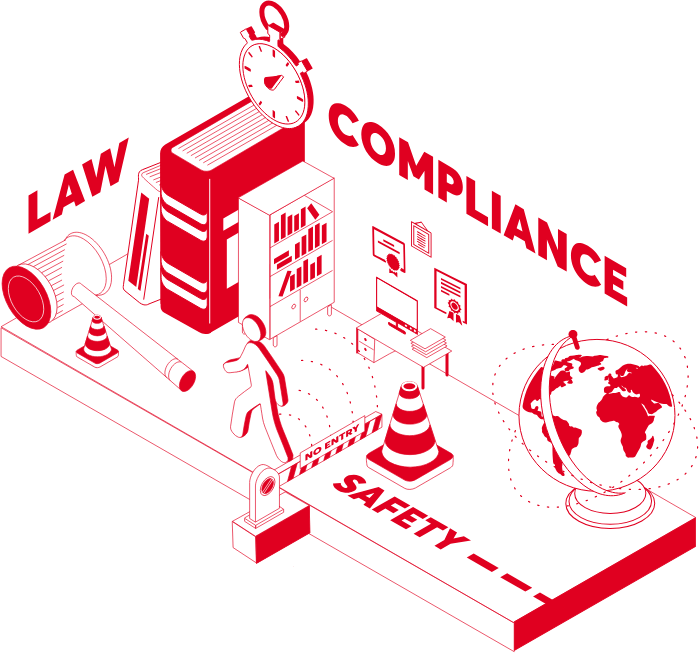A good night’s sleep is a precious commodity these days. It is even more precious in the security industry, where risk stems from many sources, and how you deal with legislative compliance is just one more risk that can have costly consequences.
In the security industry, assessing and executing risk management strategies is often an outward looking task, something you do for clients and customers. However, you shouldn’t forget to assess your own risk — the risk of not complying with legislation regarding your own employees.
For companies offering security services or those with their own security personnel, being risk-aware in your own business is a constantly moving target. It takes a lot of effort, planning and information. Risk comes in many forms that you might not have considered. So how should you approach it? Let’s assess the costs of non-compliance first.
The Financial Cost of Not Being Risk Aware
There have been many news stories about companies being sued and having to pay settlements in the tens of millions of dollars for not having complied with break legislation for their employees. One of the largest settlements in the State of California was over $100 million. This case highlighted the risk of not complying with legislation that is meant to protect and support the employees who do the daily work of providing security. For some, not only has there has been a severe financial cost, but also damage to reputation.
California isn’t the only state that has break rules for specific categories of employees. In the USA alone there are 21 states that have passed wage orders, statutes and regulations regarding meal and rest breaks. This type of legislation exists in many countries across the globe and it’s likely to increase over time.
Beyond meal and rest break legislation, the potential impact of the new U.S. overtime rules is another aspect of risk management that security companies will have to consider. According to some estimates, approximately 1.3 million workers will now have to be compensated for overtime hours. The new rules have many exemptions and require a lot of examination. The rules raise the salary threshold for eligible employees from $23,000 to $35,568, a huge 50% increase. Just consider who could that affect in your organization.
The Personnel Cost of Not Being Risk Aware
Beyond the risks associated with non-compliance, and the potential financial costs, there’s an indirect yet tangible personnel cost. If you look at it more broadly, these rules are in place to support and protect security personnel, and to also help them perform better. For example, by specifying break types and their duration, this allows security personnel to be more alert, have a more structured work day, be more focused and ultimately deliver better security.
There are other workforce and talent risks to be aware of. According to the U.S. Department of Labor, workers are staying at their jobs for shorter periods of time because of the strong economy. Tight labor markets, as well as the simple ability to join the gig economy means you have another business risk – you could lose the people who do good work for you. Especially if they feel they are not being taken care of, or worse, if they are not being given what they have rightfully earned. If employees feel like they are being mistreated or taken advantage of, they can just move on, leaving your business short of resources.
This leads to deeper organizational issues like employee retention and talent management, both of which are critical for security service companies. Hiring and keeping good talent is a costly and time-consuming task in any market. If your organization’s reputation is that of a fair and legally compliant employer, attracting and retaining talent becomes easier.
Risk Awareness & Compliance: 3 Parts to Success
It’s almost impossible to know how any new legislation might impact your security services business, and whether that will impact you financially. To deal with this, here’s a three-part recommendation: People. Process. Technology.
1. People
Make sure the people in your company– at all levels –are aware of what changes impact them, regardless of their position. Companies have internal messaging, mobile devices, emails, newsletters — leverage all of them. Make this information transparent, as that empowers anyone who wants to know. When you make it transparent, it makes it harder for people to say “I didn’t know.”
2. Process
Think of risk awareness like taking stock. Once you know what you have, what you don’t have, and what you need, you will gain transparency and clarity to make better judgments, and in turn, take preemptive actions. Every company in this space should have a plan and process to regularly review existing legislation that has changed, and what is being proposed for the regions where they operate, and then bring it to the attention of key stakeholders. It could be a legal adviser or in-house counsel. Whoever leads this activity should have as a regular task. The process to review changes doesn’t have to be complicated, since state and federal governments must post all changes in an accessible form, usually via the Internet. Being proactive about legislation will save you time and effort down the road. As the saying goes an ounce of prevention is worth a pound of cure.
3. Technology
As a direct link to the process, your workforce management technology has to be flexible enough to handle these kinds of changes, and documents them as well. Having a solution that can be adapted to take into account how legislation affects pay or work conditions is simply a best practice. The software to manage your workforce is a tool that enables the process to be documented, and the people to stay aware of risk.
Ultimately, these 3 components give you the traceability and accountability in your workforce systems, and can mean the difference between a passing an audit with flying colors, or having to pay a costly fine or deal with a legal fees.
Being aware of business risks, managing them and ensuring compliance means you’re lowering your own risk. The upside of all this – it gives key stakeholders in your company, at all levels, more peace of mind so you can focus more on the business and growth, and maybe even get a good night’s sleep.
If you want to know more about how TrackTik’s advanced Break Management simplifies and supports this issue, request a demo with us!
Request a free demo



